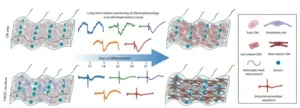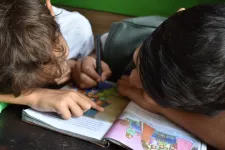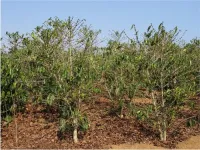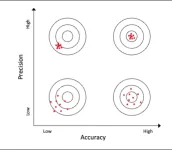(Press-News.org) A new analysis of crime statistics near hundreds of places of worship in Washington, D.C., shows that these sites are associated with higher levels of violent and property crime—even after accounting for other factors commonly linked with crime. James Wo of the University of Iowa, U.S., presents these findings in the open-access journal PLOS ONE on March 8, 2023.
Prior research has established that places of worship foster social ties and community actions for the common good, suggesting that these sites would reduce crime in their neighborhoods. However, few studies have addressed the hypothesized crime-reducing impact of places of worship.
In the present study, Wo conducted a statistical analysis of publicly available crime and neighborhood data for the areas immediately surrounding 742 places of worship across Washington, D.C.
The analysis showed that places of worship were associated with higher rates of violent and property crime in their immediate neighborhood. This association persisted even after accounting for various sociodemographic factors and other factors commonly linked with crime, such as proximity to bars, liquor stores, check-cashing stores, and D.C. metro stations.
These findings are in line with evidence from two prior studies suggesting that places of worship might unintentionally boost crime. Further research is needed to determine the mechanism by which this might occur, but it is possible that places of worship draw high foot traffic while having limited ability to monitor and regulate public activity, boosting the chances that potential offenders might seize the opportunity to commit crimes against weakly guarded targets.
The author notes that these findings do not invalidate the positive impacts of places of worship or religion. However, they suggest a need to consider places of worship as risk factors for neighborhood crime in order to accurately shape policing policies and crime-reduction efforts.
Future research could help confirm and extend these findings, such as by examining crime statistics over time as places of worship become established or shut down. Neighborhood-level data on social capital, civic engagement, foot traffic (or the ambient population), and anonymity could be collected in order to test whether these factors do, in fact, mediate the effects of places of worship on crime. Researchers could also examine whether similar patterns are seen in other cities in the U.S. and around the world.
James Wo adds: “Findings should not be interpreted as an indictment on religion or places of worship (POW). Rather, they highlight POW as an unexpected ecological risk factor for neighborhood crime, similar to how shopping malls, central business districts, restaurants, and retail stores have been deemed to operate as crime generators.”
#####
In your coverage please use this URL to provide access to the freely available article in PLOS ONE: https://journals.plos.org/plosone/article?id=10.1371/journal.pone.0282196
Citation: Wo JC (2023) Crime generators or social capital organizations? Examining the effects of places of worship on neighborhood crime. PLoS ONE 18(3): e0282196. https://doi.org/10.1371/journal.pone.0282196
Author Countries: USA
Funding: The authors received no specific funding for this work.
END
Places of worship linked with more neighborhood crime in Washington, D.C.
These sites might unintentionally provide opportunities for crime by drawing high foot traffic
2023-03-08
ELSE PRESS RELEASES FROM THIS DATE:
For educational attainment, it's more helpful to grow up in an affluent neighborhood than it is harmful to grow up in a poor one, per 23-year large Netherlands cohort study
2023-03-08
For educational attainment, it's more helpful to grow up in an affluent neighborhood than it is harmful to grow up in a poor one, per 23-year large Netherlands cohort study
###
Article URL: https://journals.plos.org/plosone/article?id=10.1371/journal.pone.0281928
Article Title: Neighbourhood effects on educational attainment. What matters more: Exposure to poverty or exposure to affluence?
Author Countries: The Netherlands, UK
Funding: The research leading to these results has received funding from the European Research Council (https://erc.europa.eu/) ...
After 6 months of disrupted schooling during COVID-19, German students scored substantially lower on intelligence tests than comparative earlier cohorts, with the gap persisting after 16 months.
2023-03-08
After 6 months of disrupted schooling during COVID-19, German students scored substantially lower on intelligence tests than comparative earlier cohorts, with the gap persisting after 16 months
###
Article URL: https://journals.plos.org/plosone/article?id=10.1371/journal.pone.0281779
Article Title: Students’ intelligence test results after six and sixteen months of irregular schooling due to the COVID-19 pandemic
Author Countries: Germany
Funding: The study was supported by a grant awarded to M.B. by the Research Fund of ...
Participants in psychology studies are more likely than average to exhibit symptoms of personality disorders, potentially skewing the findings of such research
2023-03-08
Participants in psychology studies are more likely than average to exhibit symptoms of personality disorders, potentially skewing the findings of such research
###
Article URL: https://journals.plos.org/plosone/article?id=10.1371/journal.pone.0281046
Article Title: Self-selection biases in psychological studies: Personality and affective disorders are prevalent among participants
Author Countries: Poland, Spain, Italy
Funding: To conduct Face-to-Face Studies IK was supported by grants 2017/01/X/HS6/02022 from the National Center of Science ...
A surprising way to trap a microparticle
2023-03-08
New study finds obstacles can trap rolling microparticles in fluid
Through simulations and experiments, physicists attribute the trapping effect to stagnant pockets of fluid, created by hydrodynamics
Random motions of the molecules within the fluid then ‘kick’ the microroller into a stagnant pocket, effectively trapping it
Size of the obstacle also controls how easy it is to trap a microroller and how long it remains trapped
EVANSTON, Ill. — When physicists steered a tiny microparticle toward a cylindrical obstacle, they expected one of two outcomes to occur. The particle would either collide into the ...
Fresh understanding of ageing in the brain offers hope for treating neurological diseases
2023-03-08
Scientists from the Trinity Biomedical Sciences Institute (TBSI) have shed new light on ageing processes in the brain. By linking the increased presence of specialised immune cells to conditions such as Alzheimer’s disease and traumatic brain injury for the first time, they have unearthed a possible new target for therapies aimed at treating age-related neurological diseases.
The research, which benefited from a collaboration with experts at the University of Maryland School of Medicine and focused ...
Cyborg technology analyzes the functional maturation of stem-cell derived heart tissue
2023-03-08
Research in animal models has demonstrated that stem-cell derived heart tissues have promising potential for therapeutic applications to treat cardiac disease. But before such therapies are viable and safe for use in humans, scientists must first precisely understand on the cellular and molecular levels which factors are necessary for implanted stem-cell derived heart cells to properly grow and integrate in three dimensions within surrounding tissue.
New findings from the Harvard John A. Paulson School of Engineering and Applied Sciences (SEAS) make it possible ...
Anthropogenic climate change poses systemic risk to coffee cultivation
2023-03-08
Coffee is important to the economies of coffee producing regions. A study published in PLOS Climate by Doug Richardson at CSIRO Oceans & Atmosphere, Hobart, Tasmania, Australia and colleagues suggests that climate change may significantly affect land where coffee is cultivated.
Coffee plants are sensitive to climate variability and change. However, the impact of synchronous climate hazards occurring in multiple areas important for coffee production is unknown. In order to better understand how large-scale climate modes such as El Niño ...
Celebrity sightings have a built-in contradiction
2023-03-08
RIVERSIDE, Calif. -- Their popularity makes celebrities easy to spot. Strangers, however, can also get mistaken for celebrities, resulting in cases of false “celebrity sightings.” In attempting to explain the contradiction, a University of California, Riverside, study reports that celebrity faces are remembered more precisely but less accurately.
Precision, in this context, refers to how memories for a particular face resemble each other over repeated memory retrievals, which can be likened to the clustering of arrows on a target in archery. Accuracy measures ...
A new class of drugs could prevent resistant COVID-19 variants, study finds
2023-03-08
New Haven, Conn. — The constant evolution of new COVID-19 variants makes it critical for clinicians to have multiple therapies in their arsenal for treating drug-resistant infections. Researchers have now discovered that a new class of oral drugs that acts directly on human cells can inhibit a diverse range of pathogenic SARS-CoV-2 strains.
In their newly published study, the team found a novel mechanism through which the gene that expresses angiotensin converting enzyme-2 (ACE-2)—the cellular receptor to which SARS-CoV-2 ...
Swan Hellenic and SETI Institute announce lecturers for Explore Space at Sea Series
2023-03-08
March 8, 2023, Mountain View, CA – The SETI Institute and Swan Hellenic announce SETI Institute guest lecturers who will offer cruise guests expert insights into the history and latest discoveries in astronomy, astrophysics, astrobiology and planetary science, and the quest to find other forms of life within and beyond our solar system. This quest takes SETI Institute researchers to the planet’s most remote and inhospitable corners to explore life, including Antarctica, where the Swan Hellenic fleet is present for several months every year.
Outlining ...
LAST 30 PRESS RELEASES:
University of Oklahoma researcher awarded funding to pursue AI-powered material design
Exploring how the visual system recovers following injury
Support for parents with infants at pediatric check-ups leads to better reading and math skills in elementary school
Kids’ behavioral health is a growing share of family health costs
Day & night: Cancer disrupts the brain’s natural rhythm
COVID-19 vaccination significantly reduces risk to pregnant women and baby
The role of vaccination in maternal and perinatal outcomes associated with COVID-19 in pregnancy
Mayo Clinic smartwatch system helps parents shorten and defuse children's severe tantrums early
Behavioral health spending spikes to 40% of all children’s health expenditures, nearly doubling in a decade
Digital cognitive behavioral treatment for generalized anxiety disorder
Expenditures for pediatric behavioral health care over time and estimated family financial burden
Air conditioning in nursing homes and mortality during extreme heat
The Alps to lose a record number of glaciers in the next decade
What makes a good proton conductor?
New science reporting guide published for journalists in Bulgaria
New international study reveals major survival gaps among children with cancer
New science reporting guide published for journalists in Turkey
Scientists develop a smarter mRNA therapy that knows which cells to target
Neuroanatomy-informed brain–machine hybrid intelligence for robust acoustic target detection
Eight SwRI hydrogen projects funded by ENERGYWERX
The Lundquist Institute and its start-up company Vitalex Biosciences Announces Strategic Advancement of Second-Generation fungal Vaccine VXV-01 through Phase 1 Trials under $40 Million Competitive Con
Fine particles in pollution are associated with early signs of autoimmune disease
Review article | Towards a Global Ground-Based Earth Observatory (GGBEO): Leveraging existing systems and networks
Penn and UMich create world’s smallest programmable, autonomous robots
Cleveland researchers launch first major study to address ‘hidden performance killer’ in athletes
To connect across politics, try saying what you oppose
Modulating key interaction prevents virus from entering cells
Project explores barriers to NHS career progression facing international medical graduates
Jeonbuk National University researchers explore the impact of different seasonings on the flavor perception of Doenjang soup
Two Keck Medicine of USC Hospitals named Leapfrog Top Teaching Hospitals
[Press-News.org] Places of worship linked with more neighborhood crime in Washington, D.C.These sites might unintentionally provide opportunities for crime by drawing high foot traffic










